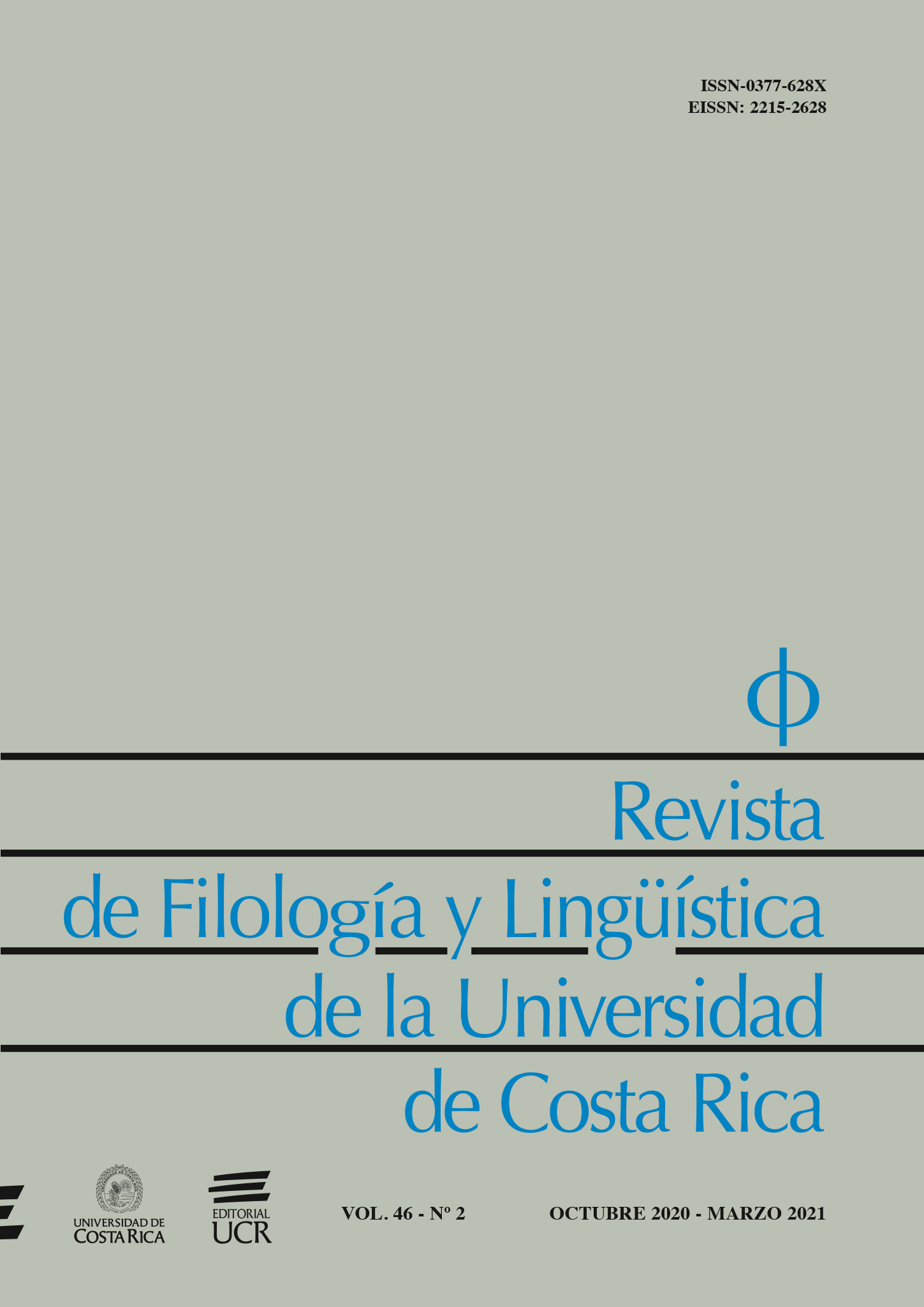Abstract
The form su/sus is a determiner with semantic content that does not encode possession exclusively. The sentences described are of the type: al pozole se le pone su lechuga, su orégano y su chile para que sepa bueno. The entities involved in this type of sentences are inanimate. These relationships express at least three subsets of inanimate relationships: parts of parts, product-components, and relations of inclusion from created referents. The description of the noun phrases in which the su/sus form appears is based on the idea that this determiner is a grammatical unit that encodes a set of features, such as definiteness, anaphora/cataphora, possession, relationship, proximity, and empathy. These features are consubstantial and co-occur simultaneously. The data used to illustrate this fact of language have been taken from different sources.
References
Arellanes Arellanes, F., Ortiz Villegas, A., Mora Bustos, A. y García Zúñiga, H. A. (setiembre, 2014). Syntax of the non-eventive semantic relations in four otomanguean languages: amuzgo, mazahua, mazatec and zapotec. Ponencia llevada a cabo en el 6th International Conference Syntax of the World’s Languages. Università di Pavia, Italia.
Bosque, I. y Gutiérrez-Rexach, J. (2008). Fundamentos de sintaxis formal. Madrid: Akal.
Company, C. (1991). La frase sustantiva en el español medieval. Cuatro cambios sintácticos. México: Universidad Nacional Autónoma de México.
Company, C. (2001). Gramaticalización, debilitamiento semántico y reanálisis. El posesivo como artículo en la evolución sintáctica del español. Revista de Filología Española, 81(1-2), 49-87.
Company, C. y Huerta, N. (2017). Frases nominales sobrespecificadas encabezadas por un posesivo átono: su casa de Juan, su casa que tiene Juan. En C. Company y N. Huerta (Eds.), La posesión en la lengua española (pp. 177-218). Madrid: Consejo Superior de Investigaciones Científicas.
Comrie, B. (1981). Language Universals and Linguistic Typology. Syntax and Morphology. Chicago: The University of Chicago Press.
Dryer, M. (2007). Noun phrase structure. En T. Shopen (Ed.), Clause Structure, Language Typology and Syntactic Description (Vol. 2) (pp. 151-205). Cambridge: Cambridge University Press.
Eberenz, R. (2000). El español en el otoño de la Edad Media. Sobre el artículo y los pronombres. Madrid: Gredos.
Eguren, L. (2018). Evaluative prenominal possessives in Spanish. Borealis: An International Journal of Hispanic Linguistics, 7(1), 1-26.
Ghomeshi, J., Paul, I., Wiltschko, M. (2009). Determiners. Amsterdam: John Benjamins Publishing Company.
Givón, T. (2001). Syntax. (Vol. 1). Amsterdam/Philadelphia: John Benjamins Publishing.
Heine, B. (1997a). Cognitive Foundations of Grammar. Oxford: Oxford University Press.
Heine, B. (1997b). Possession: Cognitive Source, Forces, and Grammaticalization. Cambridge: Cambridge University Press.
Hopper, P. y Thompson, S. (1980). Transitivity in Grammar and Discourse. Language, 56(2), 255-299.
Huerta, N. (2017). Posesivos átonos. Sintaxis y semántica. En C. Company y N. Huerta (Eds.), La posesión en la lengua española (pp. 71-131). Madrid: Consejo Superior de Investigaciones Científicas.
Jiménez, T. (2006). El paradigma determinante en español: Origen nominativo, formación y características. Verba, anexo 56.
Lenz, R. (1935). La oración y sus partes. Madrid: Junta para la Ampliación de Estudios e Investigaciones Científicas.
Leonetti, M. (1990). El artículo y la referencia. Madrid: Taurus.
Leonetti, M. (1999). El artículo. En I. Bosque y V. Demonte (Coord.), Gramática descriptiva de la lengua española (Vol. 1) (pp. 787-890). Madrid: Espasa-Calpe.
Lyons, Ch. (1993). El desarrollo de las estructuras posesivas en el español temprano. En R. Penny (Ed.), Actas del Primer Congreso Anglo-Hispano (pp. 215-223). Madrid: Castalia.
Mora, A., Ortiz, A. y García, H. A. (2019). Un determinante con contenido: el caso de su/sus. Iztapalapa Revista de Ciencias Sociales y Humanidades, 86, 11-39.
Moya-Albiol, L., Herrero, N. y Bernal, C. (2010). Bases Neuronales de la empatía. Revista de Neurología, 50(2), 89-100.
Ortiz Villegas, A. (octubre, 2015). La posesión atributiva en mazateco. Ponencia llevada a cabo en el XIII Congreso Nacional de Lingüística. Universidad Autónoma de Chiapas, Chiapas.
Ortiz Villegas, A. (abril, 2016). Sistema posesivo de las partes del cuerpo en mazateco. Ponencia llevada a cabo en el XI Coloquio de Lingüística. Escuela Nacional de Antropología e Historia, Ciudad de México.
Ortiz Villegas, A., Mora Bustos, A., Arellanes Arellanes, F. y García Zúñiga, H. A. (Abril, 2014). Codificación de relaciones semánticas no eventivas en cuatro lenguas otomangues. Ponencia llevada a cabo en el Coloquio sobre lenguas otomangues y vecinas 6. Biblioteca de Investigación Juan de Córdova, Oaxaca.
Payne, T. (2006). Exploring Language Structure. A Student’s Guide. Cambridge: Cambridge University Press.
Picallo, C. y Rigau, G. (1999). El posesivo y las relaciones posesivas. En I. Bosque y V. Demonte (Coord), Gramática descriptiva de la lengua española (Vol. 1) (pp. 973-1021). Madrid: Espasa-Calpe.
Picallo, C. y Rigau, G. (2017). La interpretación semántica de los posesivos. En C. Company y N. Huerta (Eds.), La posesión en la lengua española (pp. 267-296). Madrid: Consejo Superior de Investigaciones Científicas.
PRESEEA. (2019). Corpus del Proyecto para el estudio sociolingüístico del español de España y de América. Recuperado de http://preseea.linguas.net
Real Academia Española y Asociación de Academias Americanas. (2009). Nueva Gramática de la Lengua Española. (Vol. 1). Madrid: Espasa.
Real Academia Española. (2019). Corpus de referencia del español actual (CREA). Recuperado de http://www.rae.es/
Seiler, H. (1981). Possession as an Operational Dimension of Language, 42. Köln: Institut für Sprachwiss, Universität Köln.
Shopen, T. (1985). Language Typology and Syntactic Description. (Vol. 1, 2, 3). Cambridge: Cambridge University Press.
Taylor, J. (1999). Possession. En K. Brown y J. Miller (Eds.), Concise Encyclopedia of Grammatical Categories (pp. 300-303). Oxford: Elsevier Science.
Van Valin, R. y LaPolla, R. (1997). Syntax: structure, meaning and function. Cambridge: Cambridge University Press.

